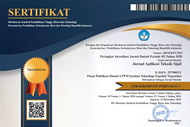Performa Mekanik Beton Berpori Untuk Aplikasi Perkerasan
Abstract
Penggunaan perkerasan jalan dengan menggunakan perkerasan konvensional banyak berdampak buruk untuk ketersediaan air dalam tanah, karena menutupi dan menghalangi air masuk kedalam tanah. Penelitian ini bertujuan menawarkan opsi yang lebih baik untuk pembangunan pavement yang ramah terhadap lingkungan menggunakan beton pori yang mampu memasukkan ke dalam tanah
Eksperimen yang digunakan adalah infiltrasi, kuat tekan dan kuat lentur. Pada penelitian ini menggunakan 6 sampel dengan variasi void 5%, 10%, 15%, 20%, 25%, 30% dan menggunakan chemical admixture silica fume dengan 10% dari berat semen.
Hasil pegujian infiltrasi menunjukkan penyerapann air yang tercepat yakni di void 5% dan paling lambat di void 30%. Hasil dari kuat tekan terbesar pad void 5% di angka 15.29 MPa dan yang terlemah di void 30%. Hasil dari kuat lentur yang terkuat terdapat pada void 5% dengan angka 1.78 MPa dan yang paling kuat dengan void 30%.Keywords
Full Text:
PDFReferences
R. Bayuaji, “Studi Kuat Tekan Beton Porus sebagai Material Alternatif Batu Bata dengan Metode Taguchi,” Jurnal Aplikasi Teknik Sipil, vol. 11, no. 2, pp. 57-64, 2014.
Hariyadi dan H. Tamai, “Enhancing the performance of porous concrete by utilizing the pumice aggregate,” dalam Procedia Engineering 125 ( 2015 ) 732 – 738, The 5th International Conference of Euro Asia Civil Engineering Forum (EACEF-5), Surabaya, 2015.
K. A. Zai, Syahrizal dan R. Karolina, “Pengaruh Penambahan Silica fume dan Superplasticizer terhadap Kuat Tekan Beton Mutu Tinggi dengan Metode ACI (American Concrete Institute),” Jurnal Teknik Sipil USU, vol. 3, no. 2, 2014.
A. M. Rosenberg dan J. M. Gaidis, “A New Mineral Admixture for High-Strength Concrete,” Concrete International Design & Construction Journal, vol. 11, no. 4, Apr. 1989.
S. Garber, R. O. Rasmussen dan D. Harrington, “Guide to Cement Based Integrated Pavement Solutions,” Institute for Transportation”, Iowa State University p. 92, Iowa, 2011.
N. Neithalath, J. Weiss dan J. Olek, “Characterizing Enhanced Porosity Using Electrical Impedence to Predict Acoustic and Hydraulic Performance,” Cement and Concrete Research Journal, vol. 36, no. 11, pp. 2074-2085, 2006.
J. Yang dan G. Jiang, “Experimental Study on Properties of Pervious Concrete Pavement Materials,” Cement and Concrete Research Journal, vol. 33, no. 3, pp. 381-386, 2003.
M. A. Bury, C. A. Mawby dan D. Fisher, “Making Pervious Concrete Placement Easy Using a Novel Admixture System,” The RMC Research & Education Foundation, Concrete Industry Management, Aug, 2013.
M. Kovac dan A. Sicakova, “Pervious Concrete as an Environmental Solution for Pavements: Focus on Key Properties,” Environments MDPI Journal, vol. 5, no. 11, pp. 1-9, 2018.
M. I. M. Yusak, R. P. Jaya, M. R. Hainin, C. R. Ismail dan M. H. W. Ibrahim, “Strength of Porous Concrete Pavement at Different Curing Methods,” Jurnal Teknologi UTM, vol. 76, no. 14, p. 99–103, 2015.
D. Dey, “Study on Compressive Strength of Pervious Concrete for Utilisation as Pavement,” International Research Journal of Engineering and Technology (IRJET), vol. 4, no. 12, pp. 809-817, 2017.
R. C. Meininger, “No-Fines Pervious Concrete for Paving,” Concrete International Journal, vol. 10, no. 8, pp. 20-27, 1988.
M. Kunieda, T. Otono, T. Yoshida, T. Kamada dan K. Rokugo, “Size effect on flexural strength of porous concrete,” dalam International Association of Fracture Mechanics for Concrete and Concrete Structures, Vail, 2004.
N. A. Brake, H. Allahdadi dan F. Adam, “Flexural strength and fracture size effects of pervious concrete,” Construction and Building Materials Journal, vol. 113, pp. 536-543, 2016.
Y. Qin, H. Yang, Z. Deng dan J. He, “Water Permeability of Pervious Concrete Is Dependent on the Applied Pressure and Testing Methods,” Advances in Materials Science and Engineering Journal, vol. 1, no. 6, pp. 1-6, 2015.
DOI: http://dx.doi.org/10.12962%2Fj2579-891X.v18i1.4645
Refbacks
- There are currently no refbacks.

Jurnal Aplikasi Teknik Sipil by Pusat Publikasi Ilmiah LPPM Institut Teknologi Sepuluh Nopember is licensed under a Creative Commons Attribution-ShareAlike 4.0 International License
Based on work at https://iptek.its.ac.id/index.php/jats




